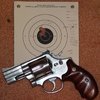When I am developing a brand new load (For Me), I first decide on a caliber, secondly, I ask myself what do I want this process to deliver, It may cause me to go back to step 1. Next I select the desired/Best Bullet, next I get into the neat part... I select Primers and Powder(s) that I plan to choose from. Then into the Books, I have Hornady, Lee, Lyman, Sierra and several Reloading Magazines that have a lot of data in them. I am sure all components have been checked and are safe and damage free for this process.
Select a Load that utilizes the Bullet/Primer/Selected Powder from previous steps. If you are unable to match everything up, change powders or bullets and continue until you can.
You should carefully increase/decrease power during each batch test. Some use .1gr increments others use .2gr. I have heard of others stepping by 1.0gr, I think that is too much. You will need to watch for Brass issues
Once you have a Load Identified, start with a Middle Of The Road load (Powder) and Load a few (Some use 3, others use 5, I personally use 10 Rounds. If you want more than 1 batch (Different Powder amount), mark those primers with a Sharpie (1 color per Batch).
As you develop loads, check Velocity, Ballistic Coefficient if available (At least G1). Select your shooting range for testing, Rifle will obviously be longer than pistol.
Records Keeping: Keep a record of each test and ALL OF THE the data, Everything spoke about above should be written down as park of you record. Even if they are a Dud, not even close to accurate. That way, you know it wont work and you have a record to prevent re-occurrence.
Bullet Weight, Type, Primer Type/Size, Powder Name, Powder Amount, it.Overall Case Length, Type of Crimp (If Any), Range Info: Weather, wind speed & Direction, Temp, Barometric Pressure if known, By Batch. I even specify the firearm used and specifics about that specific firearm. I keep data on 3X5 Cards, on Final Loads, I use 5X8 Cards printed on Printer on the white side, so I have Lines on the back in case I need to add notes at a later time
If you have or have access to a Chronograph, set it up, collect as much information as you can.
Let the tests begin keep track of each round, check brass for damage, allow a little cool down time so you don't get data errors due to the Barrel being too hot.
My experience has been, If I get in a Hurry (For whatever Reason), I will make mistakes. Then I have to disassemble, then..... Go Slow, be methdical, reloading is a process, develop a process that you are comfortable with that is safe.
Good Luck in your endeavors
Dan















